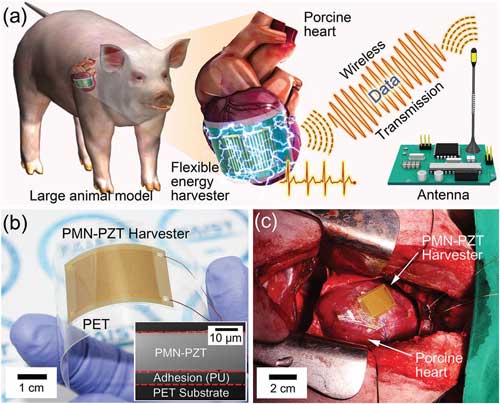| Posted: Jul 04, 2017 | |
Wireless energy harvester for implants(Nanowerk News) Researchers in Korea demonstrate the self-powered wireless data transmission enabled by harvesting in vivo biomechanical energy with a high-performance piezoelectric energy harvester in a large animal model. |
|
| Using the contraction and relaxation of a porcine heart – flexible energy harvester was sutured onto the epicardium after a median sternotomy – the team's single-crystalline flexible energy harvester generated a short-circuit current of 1.75 µA (open-circuit voltage of 17.8 V), which is higher by a factor of 17.5 than that of previously reported in vivo piezoelectric energy harvesting. | |
| The results have been published in Advanced Functional Materials ("In Vivo Self-Powered Wireless Transmission Using Biocompatible Flexible Energy Harvesters"). | |
 |
|
| a) Conceptual scheme for the in vivo self-powered system. The flexible energy harvester attached to a porcine heart generated electricity from rhythmical cardiac contraction and relaxation. Energy derived from the heart can be used in wireless data transmission which is essential to the ubiquitous healthcare system. b) The flexible energy harvester bent by human fingers. The inset is an SEM image of the single-crystalline PMN-PZT-Mn thin film on the PET substrate. c) A photograph of the device affixed to a porcine heart between the right ventricle and left ventricular apex. (© Wiley-VCH Verlag) (click on image to enlarge) | |
| The researchers also performed various cell viability tests and the histological aspects to show the biocompatibility of a flexible single-crystalline generator, which revealed no serious sign of cytotoxic damage and inflammatory reaction. | |
| In their experiments, the researchers were able to wirelessly transmit communication data using the self-powered system driven by the porcine heartbeat. It was also visually proved by repeatedly switching on and off a light bulb at a long distance of about 5 m without any other power source. | |
| Due to its accurate coincidence with the ECG signals, the energy harvester could also be applied to a heart monitoring sensor. | |
| The biocompatibility of the device was proved by a cell viability test and histological analysis. The cell viability test revealed no significant sign of cytotoxicity for various cells of three different species. | |
| Moreover, histology aspects showed that implantation of the single-crystalline device had little inflammatory reaction. | |
| This successful self-powered wireless data transmission shows the possibility of powerful application to ubiquitous healthcare systems directly using biomechanical energy harvesting. |
 By
Michael
Berger
– Michael is author of three books by the Royal Society of Chemistry:
Nano-Society: Pushing the Boundaries of Technology,
Nanotechnology: The Future is Tiny, and
Nanoengineering: The Skills and Tools Making Technology Invisible
Copyright ©
Nanowerk LLC
By
Michael
Berger
– Michael is author of three books by the Royal Society of Chemistry:
Nano-Society: Pushing the Boundaries of Technology,
Nanotechnology: The Future is Tiny, and
Nanoengineering: The Skills and Tools Making Technology Invisible
Copyright ©
Nanowerk LLC
|
|
|
Subscribe to a free copy of one of our daily Nanowerk Newsletter Email Digests with a compilation of all of the day's news. |
